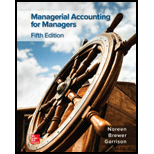
Concept introduction:
Activity-based costing (ABC):
Activity-based costing refers to the method of costing where the
Requirement 1:
Calculate the cost of serving each of the given parties of diners.
Concept introduction:
Cost allocation:
Cost allocation refers to the process where the common cost of the production and service rendered to the various departments of the business are distributed. It is used to calculate the actual cost attributed to a specific department.
Requirement 2:
Calculate the average cost per diner for serving each of the following parties.
Concept introduction:
Cost allocation:
Cost allocation refers to the process where the common cost of the production and service rendered to the various departments of the business are distributed. It is used to calculate the actual cost attributed to a specific department.
Requirement 3:
Provide the reason behind the difference in the cost per diner for the three different parties.
Want to see the full answer?
Check out a sample textbook solution
Chapter 5 Solutions
Managerial Accounting for Managers
- The variable cost is $16 per unit for a product that sells for $20. For 2,000 units, what is the contribution margin and contribution margin per unit? A. $8,000; $4 B. $8,000; $8 C. $12,000; $16 D. $20,000; $20arrow_forwardgross profit on each glass ??arrow_forwardI am looking for help with this general accounting question using proper accounting standards.arrow_forward
- calculate net income ...?arrow_forwardgeneral accountingarrow_forwardGiven the following cost and activity observations for Smithson Company's utilities, use the high-low method to calculate Smithson's fixed costs per month. Cost Machine Hours January $3,080 14,719 February $2,669 10,205 March $2,806 12,138 April $3,573 18,476 A. $2,669 B. $3,032 C. $1,554 D. $1,471arrow_forward
- what is the unit variable cost ???arrow_forwardPlease provide the solution to this general accounting question using proper accounting principles.arrow_forwardThe output of a company's assembly department during the period consists of 32,000 units completed and transferred out, and 18,000 units in ending Work in Process that were 40% complete as to materials and conversion costs. The beginning inventory was 15,000 units that were 20% complete as to materials and conversion costs. Under the weighted-average method, what are the equivalent units of production for materials? a. 39,200 b. 32,000 c. 7,200 d. 41,000arrow_forward

 AccountingAccountingISBN:9781337272094Author:WARREN, Carl S., Reeve, James M., Duchac, Jonathan E.Publisher:Cengage Learning,
AccountingAccountingISBN:9781337272094Author:WARREN, Carl S., Reeve, James M., Duchac, Jonathan E.Publisher:Cengage Learning, Accounting Information SystemsAccountingISBN:9781337619202Author:Hall, James A.Publisher:Cengage Learning,
Accounting Information SystemsAccountingISBN:9781337619202Author:Hall, James A.Publisher:Cengage Learning, Horngren's Cost Accounting: A Managerial Emphasis...AccountingISBN:9780134475585Author:Srikant M. Datar, Madhav V. RajanPublisher:PEARSON
Horngren's Cost Accounting: A Managerial Emphasis...AccountingISBN:9780134475585Author:Srikant M. Datar, Madhav V. RajanPublisher:PEARSON Intermediate AccountingAccountingISBN:9781259722660Author:J. David Spiceland, Mark W. Nelson, Wayne M ThomasPublisher:McGraw-Hill Education
Intermediate AccountingAccountingISBN:9781259722660Author:J. David Spiceland, Mark W. Nelson, Wayne M ThomasPublisher:McGraw-Hill Education Financial and Managerial AccountingAccountingISBN:9781259726705Author:John J Wild, Ken W. Shaw, Barbara Chiappetta Fundamental Accounting PrinciplesPublisher:McGraw-Hill Education
Financial and Managerial AccountingAccountingISBN:9781259726705Author:John J Wild, Ken W. Shaw, Barbara Chiappetta Fundamental Accounting PrinciplesPublisher:McGraw-Hill Education





